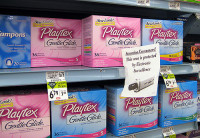By ISABELLA SANTOS and STEPHANIE TREFCER
President Obama has called for removal of “luxury tax” on feminine hygiene products.
YouTube lifestyle blogger, Ingrid Nilsen, interviewed President Obama on Jan. 16 on the so-called luxury tax. Obama stated that he was “unaware of the tax and had no idea as to why these companies continued to tax tampons as a luxury item.” Women actually pay about $1,000 more on toiletries than men, dubbed the ‘pink tax.’
“We shouldn’t be taxed for having our periods every 25-28 days, that’s similar to taxing men’s shaving gear because they grow hair,” Kayla Ambrose, 20, of Beachwood, N.J. said.
A 1995 California study revealed that women pay $1,351 a year more than men on the same every day hygienic products. Throughout the recent years, states across the country have chosen to participate in taxing these product, while the state of New Jersey has become exempt from this Governmental State Tax.
According to Rachel Kaufman of The Penny Hoarder, women spend a total of about $1,300 a year when purchasing “pink products.” However, the price gap is not strictly limited to toiletries. In addition to the estimated 14 percent increase in prices at the drugstore, women also spend 57 percent more on haircuts and 92 percent more for dry cleaning services, among other things.

“Products are products, a razor is a razor. Why are people basing the price on the gender of the consumer?” Alex Agravante, 19, of Ramapo College said.
It is no surprise that the tax is considered a luxury item, when the prices for sundries differ among men and women. For example, according to the University of Central Florida, research has shown that on average, woman’s deodorant alone costs 30 cents higher than men’s.
“I believe it is absolutely ludicrous that women have to pay an extra tax to regulate something beyond their control, Joseph DePierro, 21, of Ramapo College said. “That’s like charging men for deodorant and shaving supplies and those are necessities, too.”
In 2010, Consumer Reports, conducted research in the drugstore to discover which products specifically were affected by the tax. According to the study, Barbasol shaving cream for men was priced 11 cents less than the women’s product. Degree’s antiperspirants for women contained less product than the men’s, forcing women to purchase more frequently. Blatantly targeting women, Midol, a pain reliever for cramps and premenstrual syndrome, cost 50 cents more than regular Excedrin.
Nicholas Libraro, a 20-year-old junior at Ramapo College was shocked about the luxury tax on menstrual cycle related items.
“I did not know it was classified as a ‘luxury’ tax, because truly I’ve never met a woman who was comfortable on their period.”
As more consumers are being made aware of the presence of the tax, news outlets are providing more coverage to the public addressing the connection between the wage gap in certain corporations to the price difference in products.
New Jersey residents, ranging from collegiate age and older it was evident that the tax was something most consumers, whether identified as men or women, found unnecessary.
“It isn’t a luxury if we can’t help it,” Ursula Eljouzi, 47, of Wayne, N.J. said,” it’s a natural process that we cannot control.”
This is a well written article, but I wish it ended with some information as to what actions are being taken to eliminate the “luxury tax.” The comparison between costs of male and female products educates the reader, but we are missing what the next step is. Where does the story go from here?
The article was an easy read and written well, however, I thought that the quotes that were used were repetitive at the beginning. Also, in the interview that was with the president, did he mention any details on the call for the removal of luxury tax?